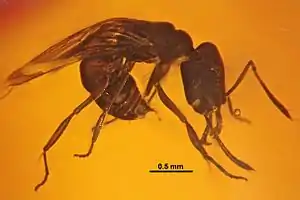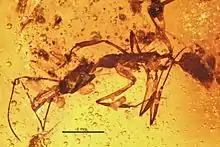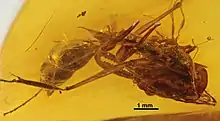Домініканський бурштин
Домініканський бурштин — різновид бурштину з острову Гаїті (Домініканська республіка). Датується міоценом (близько 20 мільйонів років; раніше вважався більш давнім). Містить багато викопних членистоногих з міоцену, особливо комах. Є одним з найбільш масово добуваних бурштинів. Видобувається у шахтах в горах острову. Буває забарвленим у різні відтінки жовтого, червоного, зеленого та зрідка блакитного (блакитний бурштин).

Палеобіологія
Утворився зі смоли викопного листяного дерева Hymenaea protera (бобові).
Від самого масового і відомого балтійського бурштину відрізняється більшою прозорістю і відносно великою кількістю викопних включень. Це дозволило детально відновити структуру давно зниклих екосистем тропічних лісів.[1]
Численні організми були описані з екземплярів бурштину, в тому числі:


Рослинний світ
- Discoflorus neotropicus[4]
- Hymenaea protera
- Palaeoraphe
- Roystonea palaea
Тваринний світ
- Acanthostichus hispaniolicus[5]
- Anelaphus velteni
- Anochetus ambiguus[6]
- Anochetus brevidentatus[7]
- Anochetus conisquamis[6]
- Anochetus corayi [8]
- Anochetus dubius[6]
- Anochetus exstinctus[6]
- Anochetus intermedius[6]
- Anochetus lucidus[6]
- Apterostigma electropilosum[9]
- Apterostigma eowilsoni[9]
- Araneagryllus
- Augochlora leptoloba
- Azteca alpha[10]
- Azteca eumeces[10]
- Cephalotes jansei[11]
- Dicromantispa electromexicana[12]
- Dicromantispa moronei[12]
- Eickwortapis
- Electromyrmococcus[13]
- Elaphidion inclusum
- Elaphidion tocanum
- Formicodiplogaster myrmenema[14]
- Leptofoenus pittfieldae
- Lutzomyia adiketis[15]
- Neocorynura electra
- Nesagapostemon
- cf. Nesoctites [16]
- Odontomachus pseudobauri[6]
- Odontomachus spinifer[6]
- Oligochlora
- Palaeoplethodon
- Plectromerus grimaldii
- Plectromerus tertiarius
- Pterolophosoma otiliae
- Sphaerodactylus dommeli[17]
- Stizocera evanescens
- Syndesus ambericus [18]
- Tainosia[19]
- Termitaradus mitnicki
- Triatoma dominicana
Посилання та джерела
Примітки
- George Poinar, Jr. and Roberta Poinar, 1999. The Amber Forest: A Reconstruction of a Vanished World, (Princeton University Press) ISBN 0-691-02888-5
- Poinar, G. (2014). Evolutionary history of terrestrial pathogens and endoparasites as revealed in fossils and subfossils.. Advances in Biology 2014: 1–29. doi:10.1155/2014/181353. Проігноровано невідомий параметр
|doi-access=(довідка) - Poinar, G. (2005). Triatoma dominicana sp. n. (Hemiptera: Reduviidae: Triatominae), and Trypanosoma antiquus sp. n. (Stercoraria: Trypanosomatidae), the First Fossil Evidence of a Triatomine-Trypanosomatid Vector Association. Vector-Borne and Zoonotic Diseases 5 (1): 72–81. PMID 15815152. doi:10.1089/vbz.2005.5.72.
- Ancient Termite Pollinator of Milkweed Flowers in Dominican Amber Poinar GO Jr. American Entomologist 2017 63:52-59
- De Andrade, M. L. (1998). First description of fossil Acanthostichus from Dominican amber (Hymenoptera: Formicidae). Mitteilungen der Schweizerischen Entomologischen Gesellschaft 71: 269–274.
- De Andrade, M. L. (1994). Fossil Odontomachiti Ants from the Dominican Republic (Amber Collection Stuttgart: Hymenoptera, Formicidae. VII: Odontomachiti). Stuttgarter Beiträge zur Naturkunde. Serie B (Geologie und Paläontologie) 199: 1–28.
- MacKay, W. P. (1991). Anochetus brevidentatus, new species, a second fossil Odontomachiti ant (Hymenoptera: Formicidae). Journal of the New York Entomological Society 99: 138–140.
- Baroni Urbani, C. (1980). Anochetus corayi n. sp., the first fossil Odontomachiti ant. (Amber Collection Stuttgart: Hymenoptera, Formicidae. II: Odontomachiti). Stuttgarter Beiträge zur Naturkunde. Serie B (Geologie und Paläontologie) 55: 1–6.
- Schultz, T.R. (2007). The fungus-growing ant genus Apterostigma in Dominican amber.. Memoirs of the American Entomological Institute 80: 425–436.
- Wilson, E.O. (1985). Ants of the Dominican amber (Hymenoptera: Formicidae). 3. The subfamily Dolichoderinae.. Psyche 92: 17–37. doi:10.1155/1985/20969. Проігноровано невідомий параметр
|doi-access=(довідка) - Cephalotes jansei Vierbergen and Scheven 1995 (ant). Fossil works. Процитовано 22 січня 2019.
- Engel, MS; Grimaldi, DA (2007). The neuropterid fauna of Dominican and Mexican amber (Neuropterida, Megaloptera, Neuroptera). American Museum Novitates (3587): 1–58. doi:10.1206/0003-0082(2007)3587[1:TNFODA]2.0.CO;2. Проігноровано невідомий параметр
|hdl=(довідка) - Johnson, M.S. (2001). Acropyga and Azteca Ants (Hymenoptera: Formicidae) with Scale Insects (Sternorrhyncha: Coccoidea): 20 Million Years of Intimate Symbiosis. American Museum Novitates (3335): 1–18. doi:10.1206/0003-0082(2001)335<0001:AAAAHF>2.0.CO;2.
- Poinar, G.O. (2011). The Evolutionary History of Nematodes: As Revealed in Stone, Amber and Mummies. Nematology Monographs and Perspectives Pages 9: 91–93, 239–240, 324–325.
- Poinar, G. (2008). Lutzomyia adiketis sp. n. (Diptera: Phlebotomidae), a vector of Paleoleishmania neotropicum sp. n. (Kinetoplastida: Trypanosomatidae) in Dominican amber. Parasites & Vectors 1 (1): 22. PMC 2491605. PMID 18627624. doi:10.1186/1756-3305-1-22.
- Laybourne, R.C.; Deedrick, D.W.; Hueber, F.M. (1994). Feather in amber is earliest New World fossil of Picidae. Wilson Bulletin 106 (1): 18–25.
- Daza, Juan Diego; Bauer, A. M.; Wagner, P.; Böhme, W. (1 січня 2012 (26 Sep 2012 online)). A reconsideration of Sphaerodactylus dommeli Böhme, 1984 (Squamata: Gekkota: Sphaerodactylidae), a Miocene lizard in amber. Journal of Zoological Systematics and Evolutionary Research 51: 55–63. ISSN 1439-0469. doi:10.1111/jzs.12001. «Subsequent to the acceptance of this paper, we obtained high resolution X-ray computed tomography imagery for the paratype of Sphaerodactylus dommeli that confirms that it is correctly allocated to genus. Details of its osteology will be reported elsewhere.»
- Woodruff, R.E. (2009). A new fossil species of stag beetle from Dominican Republic amber, with Australasian connections (Coleoptera: Lucanidae). Insecta Mundi 0098: 1–10.
- Szwedo, J.; Stroiński, A. (2001). Tainosia quisqueyae gen. and sp. nov. from the Oligocene/Miocene Dominican amber (Hemiptera: Fulgoroidea: Nogodinidae). Genus 12 (1): 29–34.
